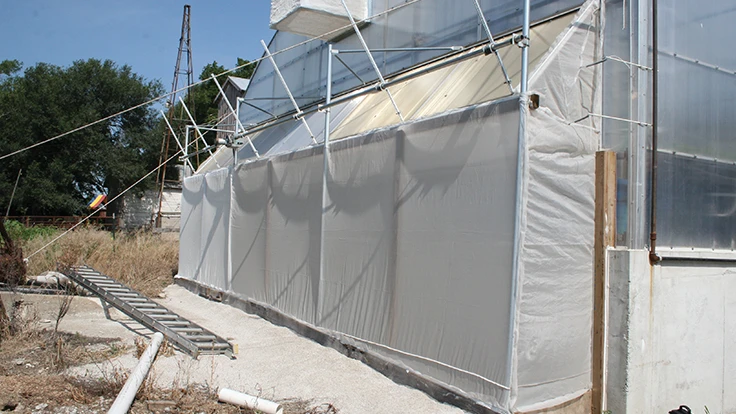

Consumers’ desire for pesticide-free ornamental and edible crops, coupled with the increase of greenhouse pest populations and their resistance to traditional chemical pesticides, has led to many growers taking a different approach to their pest management plan.
With continuing advancements in insect screening, greenhouse growers can take a proactive step toward reducing insect pests and installing this technology over greenhouse vent openings.
“Screening isn’t cheap, there is an initial investment. But in the long run there is a savings in the reduction of pesticide applications, cleaner plants [and a] healthier environment,” says Dr. Raymond Cloyd, an entomologist, professor and extension specialist at Kansas State University.
He adds that insect screening should be part of any IPM program and is compatible with the use of biological controls.
Insect screening can help keep out the common insects that plague a greenhouse. Properly sized and fitted insect screening will also keep the beneficial insects from escaping, but more importantly it will keep flying insects out that Cloyd says “inundate the biologicals” like thrips (Thysanoptera), whiteflies (Aleyrodidae), onion or allium leafminers (Phytomyza gymnostoma Loew), and shore flies (Ephydridae).
He added this is particularly important in locations where greenhouses are near adjoining fields of corn, soybeans and other crops, where insects can enter the greenhouse from the fields, particularly during harvest time.
Sizing up the situation
Once a grower gets the go-ahead from procurement to invest in greenhouse screening, the next course of action is to select the right screening for their greenhouse.
“The first thing I ask them to do is contact the National Greenhouse Manufacturers Association,” Cloyd says. “This association has guidelines on how to install this screening; you just can’t put screening on your vents, you’ll burn out your fans.”
Cloyd says he has worked with many growers in the installation stage of greenhouse screening. He says the first step in properly installing insect screens involves calculating the square footage of space needed for the cages or boxes that are installed on the exterior of the greenhouse. The cages provide adequate ventilation and cooling while preventing fan motors from burning out.
The other consideration is the size of the holes or pore spaces in the screening opening. Cloyd says researchers at Kansas State have used anti-virus screening for years for their greenhouses because it will keep viruses, as well as the smallest insects, from coming in. Thrips, for example, are narrow and thin, and can squeeze through some of the smallest openings.
In his book “Greenhouse Pest Management,” Cloyd advises greenhouse operators to install the insect screening based on the smallest insect that needs to be excluded and says that a virus screen may also reduce the incidence of viral diseases, such as the impatiens necrotic spot and tomato spotted wilt viruses, both vectored by the western flower thrip.

Accordion screening
A relatively new type of insect screening is a folding, or accordion, system, which is sold by Holland Gaas, a company in the Netherlands. Accordion screening can be installed over venlo vents, continuous vents, sidewall vents or butterfly vents outside a greenhouse.
“Insect [screening] has made a bunch of leaps from the beginning — from pest [screening] over padded end walls and cages — to the newest innovation, accordion netting,” says Julie Gilbert-Vijverberg, director of Batesville, Indiana-based G & V Greenhouse Solutions and U.S. representative for Holland Gaas. She says in addition to making a tight seal to keep out the invading marauders, accordion screening has the ability to buffer the effects of sudden downpours, depending on the size of the mesh, but quickly adds that the best defense against inclement weather is to shut the vents.
Gilbert-Vijverbert says greenhouse owners should consult with their greenhouse manufacturers before installing accordion screening to find out the projected cubic feet per minute (CFM) of their fans and see if the openings need to be retrofitted with cages or boxes to maintain adequate air flow. Newer greenhouses may not need the boxes and cages. She says her company works with greenhouse growers to determine the appropriate screening for their greenhouses, based on the need to maintain adequate air flow and cooling.
“I consult with them about what to do with their air flow, when to vent, when not to vent,” she says. She adds that a greenhouse manufacturer or a greenhouse construction company can help configure the airflow reduction to have adequate airflow for growers’ greenhouse needs.
Maintaining your screening
Standard greenhouse screens can last from five to 10 years if it is maintained properly, Cloyd says.
“You’ve got to keep them clean because dirt and debris can build up,” he says. “I know growers who have used them for up to 10 years.”

Gilbert-Vijverberg recommends cleaning the screening once a year, especially if your houses are located near farm fields where farmers are plowing. The debris that is kicked up by the plowing clings to the screens, reducing ventilation. Gilbert-Vijverberg says growers can clean the surface of accordion screening by using a pressure washer set at 2500 psi with a fan tip and lightly spraying from the inside out, or if thrips are your main problem, from the outside in. She says conventional greenhouse screening should be cleaned with a garden hose and spray gun.
Not only will insect screening reduce the use of pesticides and complement a biological control program, but for vegetable growers it could mean higher profits as they can charge more for crops grown organically.
“The dramatic drop of pesticide use is insurmountable,” Gilbert-Vijverberg says. “The price you can charge for your tomatoes or cucumbers goes up because the market is friendly for non-pesticides.”
The bottom line is the more you have invested in a crop, the more you need to protect it, and insect screening not only provides a good insect barrier but a level of security that all is well with your crop.
The return on investment (ROI) from purchasing insect screening can be measured by the reduction in pesticide usage and labor, Gilbert-Vijverberg says.
“A large grower with 15 acres or more could lose hundreds of millions of dollars and contracts with buyers if a crop fails” Gilbert-Vijverberg says.
Ultimately, it’s about providing the best protection for your crops in a greenhouse, whether it be petunias or peppers. Insect screening is another consideration for growers looking for crop protection and peace of mind.

Explore the January 2019 Issue
Check out more from this issue and find your next story to read.
Latest from Greenhouse Management
- North Carolina Nursery & Landscape Association announces new executive vice president
- Plant Development Services, Inc. unveils plant varieties debuting in 2025
- Promo kit available to celebrate first National Wave Day on May 3
- Applications now open for American Floral Endowment graduate scholarships
- Endless Summer Hydrangeas celebrates 20 years with community plantings
- Invest in silver
- Garden Center magazine announces dates for 2025 Garden Center Conference & Expo
- USDA launches $2 billion in aid for floriculture growers





